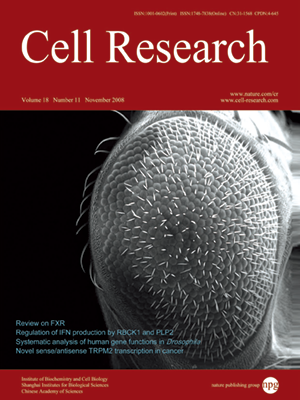
Volume 18, No 11, Nov 2008
ISSN: 1001-0602
EISSN: 1748-7838 2018
impact factor 17.848*
(Clarivate Analytics, 2019)
Volume 18 Issue 11, November 2008: 1128-1140
ORIGINAL ARTICLES
Identification of novel sense and antisense transcription at the TRPM2 locus in cancer
Ugo Orfanelli1, Ann-Kathrin Wenke2, Claudio Doglioni1, Vincenzo Russo1, Anja Katrin Bosserhoff2 and Giovanni Lavorgna1
1DIBIT - San Raffaele Scientific Institute, Via Olgettina 58, 20132 Milan, Italy;
2Institute of Pathology, University of Regensburg, Franz-Josef-Strauss-Allee 11, D-93053 Regensburg, Germany
Correspondence: Giovanni Lavorgna(giovanni.lavorgna@hsr.it)
It has been proposed that in cancer, where the bulk of the genome becomes hypomethylated, there is an increase in transcriptional noise that might lead to the generation of antisense transcripts that could affect the function of key oncosuppressor genes, ultimately leading to malignant transformation. Here, we describe the computational identification of a melanoma-enriched antisense transcript, TRPM2-AS, mapped within the locus of TRPM2, an ion channel capable of mediating susceptibility to cell death. Analysis of the TRPM2-AS genomic region indicated the presence in the same region of another tumor-enriched TRPM2 transcript, TRPM2-TE, located across a CpG island shared with TRPM2-AS. Quantitative PCR experiments confirmed that TRPM2-AS and TRPM2-TE transcripts were up-regulated in melanoma, and their activation was consistent with the methylation status of the shared CpG island. Functional knock-out of TRPM2-TE, as well as over-expression of wild-type TRPM2, increased melanoma susceptibility to apoptosis and necrosis. Finally, expression analysis in other cancer types indicated that TRPM2-AS and TRPM2-TE over-expression might have an even wider role than anticipated, reinforcing the relevance of our computational approach in identifying new potential therapeutic targets.
Cell Research (2008) 18:1128-1140. doi: 10.1038/cr.2008.296; published online 28 October 2008
FULL TEXT | PDF
Browse 1876


